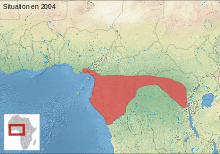Acanthixalus spinosus
| Acanthixalus spinosus | |
|---|---|
| Scientific classification | |
| Kingdom: | Animalia |
| Phylum: | Chordata |
| Class: | Amphibia |
| Order: | Anura |
| Family: | Hyperoliidae |
| Genus: | Acanthixalus |
| Species: | A. spinosus |
| Binomial name | |
| Acanthixalus spinosus | |
 | |
| Synonyms[2] | |
|
Hyperolius spinosus Buchholz and Peters, 1875 | |
Acanthixalus spinosus is a species of frog in the family Hyperoliidae, the sedge and bush frogs. It is native to Africa, where it can be found in southeastern Nigeria and south- and eastward to Cameroon, Gabon, the Democratic Republic of the Congo, and the Republic of the Congo. It is also presumed to occur in the intervening/adjacent countries of Angola (in the Cabinda enclave), Equatorial Guinea, and the Central African Republic.[1][2][3] Common name African wart frog has been coined for this species.[2]
Description
Males measure 30–38 mm (1.2–1.5 in) and females 32–36 mm (1.3–1.4 in) in snout–vent length.[4] The dorsum is warty, black or brownish to olive in color, and bears an hourglass pattern consisting of very irregular transverse bands on dorsum and limbs.Males have no vocal sac or vocal sac openings and are believed to be mute. Males also have strong spines on the tarsus, and they have larger digital discs than females.[3]
The tadpoles grow to 60 mm (2.4 in) in total length. Newly metamorphosed juveniles are brightly colored: they are dorsally orange, with the top of the head and bars across the middle of the back and in the lumbar region deep maroon.[3]
Habitat and conservation
This frog lives in lowland rainforest. It is mostly aquatic, living in water-filled holes in trees.[1][4] Apparently, they leave the tree holes only during night to forage.[4] The eggs are deposited a few centimeters above the water surface. Upon hatching, the tadpoles fall into the water. The development takes approximately three months. They are detritivores.[3]
Because this species depends on large trees with holes that collect rainwater, it is vulnerable to ongoing forest loss.[1]
Ecological interactions
This frog is host to the commensal protists Opalina proteus and Cepedea couillardi.[5]
References
- 1 2 3 4 IUCN SSC Amphibian Specialist Group (2013). "Acanthixalus spinosus". IUCN Red List of Threatened Species. IUCN. 2013: e.T56055A18369717. doi:10.2305/IUCN.UK.2013-2.RLTS.T56055A18369717.en. Retrieved 9 December 2016.
- 1 2 3 Frost, Darrel R. (2016). "Acanthixalus spinosus (Buchholz and Peters, 1875)". Amphibian Species of the World: an Online Reference. Version 6.0. American Museum of Natural History. Retrieved 4 December 2016.
- 1 2 3 4 "Acanthixalus spinosus". AmphibiaWeb: Information on amphibian biology and conservation. [web application]. Berkeley, California: AmphibiaWeb. 2001. Retrieved 9 December 2016.
- 1 2 3 Rödel, Mark-Oliver; Kosuch, Joachim; Veith, Michael; Ernst, Raffael (March 2003). "First record of the genus Acanthixalus Laurent, 1944 from the upper Guinean rain forest, West Africa, with the description of a new species". Journal of Herpetology. 37 (1): 43–52. doi:10.1670/0022-1511(2003)037[0043:FROTGA]2.0.CO;2.
- ↑ Affa'a, Félix-Marie; Mignot, Jean-Pierre; Amiet, Jean-Louis (1996). "Morphological and cytological observations on two opalinid endocommensals of Acanthixalus spinosus (Amphibia, Anura)". Canadian Journal of Zoology. 74 (8): 1573–1584. doi:10.1139/z96-171.
